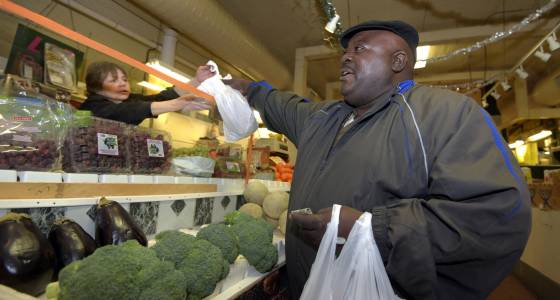Francis "Lumpy" Baroch remembers when the center aisle at Hollins Market was so crowded it had to be widened. Today, customers trickle past his L&R Produce stall at the east end of the market. Stalls at the west end of the aging structure stand empty.
Market managers, merchants, officials and customers are hoping that will soon change.
Hollins is one of four public city markets slated for a major overhaul as operators work to keep them relevant in Baltimore's changing and competitive foodscape.
Developers have submitted plans for revamping Hollins and Broadway markets. A $40 million rebuild is proposed for Lexington Market. And the business community is watching Cross Street Market after the collapse of a public-private partnership to overhaul that space.
New partnerships with private players will likely be necessary to update the markets and bring back the bustling crowds of their heyday, longtime market managers say. Faced with slim profit margins and new competition, public market operators are refocusing on the roles these institutions were always intended to play: serving their neighborhoods with healthful, accessible foods, and supporting local entrepreneurs.
At the Hollins Market, Gerald Blue, 53, from Westport buys fresh produce from L&R Produce from Linda Sweitzer, cousin to the owner, Francis Baroch.
At the Hollins Market, Gerald Blue, 53, from Westport buys fresh produce from L&R Produce from Linda Sweitzer, cousin to the owner, Francis Baroch.
Social centers
Baltimore claims to have the oldest continuously operating public market system in the country; the six existing markets have roots that date to the late 1700s. They have burned down and been rebuilt, and seen business grow and decline. But for more than 200 years, the markets have maintained a "come-one, come-all" ambience and served as centers of community.
"The areas were built around them specifically — the market is the center of the village or the neighborhood they're in," said David K. O'Neil, an international public market consultant based in Philadelphia. "The social component of the market is very, very important."
When Revolutionary War general John Eager Howard donated land for a market on the western outskirts of Baltimore in 1782, it was intended as a meeting point for residents of the young city and rural farmers.
Since then, what became known as Lexington Market has undergone repeated metamorphoses as...
When Revolutionary War general John Eager Howard donated land for a market on the western outskirts of Baltimore in 1782, it was intended as a meeting point for residents of the young city and rural farmers.
Since then, what became known as Lexington Market has undergone repeated metamorphoses as...
For most of their history, Baltimore's public markets were managed by the city. Officials created the nonprofit Baltimore Public Markets Corp. in 1995 to take over management of Northeast, Cross Street, Broadway, Hollins and the now-closed Belair market. The organization assumed management of the Avenue Market in 2001. Lexington Market Inc., a separate entity, has managed Lexington Market since 1979.
Baltimore's public markets are still neighborhood cornerstones, but the spaces have underperformed. They have not kept pace with shifts in Baltimore's demographics, real estate trends or evolving food access strategies in cities, said Robert Thomas, executive director of Lexington Market Inc. and the Baltimore Public Markets Corp.
The buildings are due for structural upgrades, Thomas said, and improvements are also intended to meet the needs of current tenants, fill empty stalls with new merchants and draw new customers.
O'Neil warns that change can be difficult.
"Everyone's interconnected and it's all based on relationships, and people can get very nervous and very upset and they will react to protect their immediate self-interests," he said. "[The markets are] cherished, actually, even if they're not performing up to speed."
That became evident as the deal to redevelop Cross Street Market fell apart. The rundown building has an occupancy rate of 51 percent, the lowest among Baltimore's public markets. Caves Valley Partners proposed a $6.5 million overhaul to remodel the building, add new tenants and keep most existing vendors, barring anchor tenant Nick's Inner Harbor Seafood. The firm backed out after backlash from vendors and neighbors wary of the proposed changes.
As market managers look to make upgrades, O'Neil said, it can be challenging to meet the changing needs of consumers, who sometimes aren't aware of what they truly want.
"That's where management comes in," he said. "Keeping that front end fresh, keeping it open."
Models for success
Thomas said his organization doesn't have the capacity to handle renovations and management on its own. He said funding will need to come from a mix of public and private sources, and private firms could also help manage the spaces.
Baltimore's market organizations are breaking even, Thomas said, on revenues of about $5 million annually at Lexington Market and $3 million for the five markets of Baltimore Public Markets Corp. combined. Currently, Lexington Market receives $173,607 in grants from the city. The rest receive $138,885.
It's difficult to draw private investment to public markets because the profit margins are tight. O'Neil describes his tenure as general manager of Reading Terminal Market in Philadelphia from 1980 to 1990. "Back in 1980, the Reading Terminal Market was very neglected, very empty," he said. "Not completely empty, but I like to say there were more rats than people."
Change came piece by piece through a series of small adjustments: killing the rats; cleaning the building; adding a new facade. Half the battle, O'Neil said, was changing the perception around Reading Terminal.
"The only way to address that is through action," O'Neil said.
Eventually, the market's 23 vendors grew to 80. He recruited a mix of tenants — focusing on diversity of products as well as diversity among the races, income levels and backgrounds of the merchants themselves.
Throughout the transition, O'Neil said, the market had to prioritize public goals over profit, and Baltimore should do the same.
Those goals include spurring entrepreneurship, addressing public health needs and staying accessible to customers at all demographics and income levels.
The Fresh at the Avenue stall has already put Upton's Avenue Market on that path. The stand, which marked its first full year in business on Saturday, provides produce to residents of what is otherwise a food desert.
The stand was created by the No Boundaries Coalition. Tiffany Welch, a food justice organizer with the group, said customers have begun using it for weekly shopping.
"It definitely is a ripple effect," she said.
Thomas said Baltimore's markets, particularly the Avenue Market, are working toward becoming destinations that spur economic development in the neighborhoods they serve. But it's hard to attract investment to areas in transition.
"It's an interesting chicken-and-egg circumstance," Thomas said.
Neighborhood staples
Each of Baltimore's markets has a distinct atmosphere, and what works at one may not suit another.
Northeast Market, a couple of blocks from Johns Hopkins Hospital, is a lunch staple for workers such as Suzanne Ayd. The 55-year-old Bel Air woman, who works at Hopkins, said she's been visiting for more than 30 years. "The food is better and cheaper, and there's more variety here" than in the hospital's cafeteria, she said. "A lot of the same stalls are still here."
Markets such as Hollins attract carry-out customers but serve more frequently as alternatives to grocery stores.
At Jack's Poultry in Hollins Market, whole chickens, thighs, breasts and wings of all sizes sit on ice. Customers step up and point to the pieces they want to take home.
During more than 60 years in business, the offerings at the poultry stand have changed, according to Ben David, a third-generation operator. More customers want chicken parts rather than whole birds these days, he said. But generations of patrons have remained loyal.
"I think they just trust us," said David, whose grandfather opened Jack's Poultry in 1953. "From grandpa to my dad to me, we try to have integrity in what we do and be honest and very up-front, and that's why you can kind of see everything that you're getting right away."
That's what Gerald Blue, 53, enjoys about shopping at Hollins Market. "You come right in, you usually see what you want right there. You can hand it to them and just keep on going," he said.
The Westport man said he has been shopping at Hollins twice a week for more than 20 years. He was buying fruit salad, vegetables, oxtails and chicken on a recent visit. He said he wouldn't mind seeing some upgrades at the market, but hopes the interactions with vendors don't change.
Market vendors build relationships with customers, and may allow some bargaining. At L&R Produce, Baroch sells apples at five for $2.50 — but sometimes he'll give customers 10 or 12 for $4.
"That couple apples ... you could give an inch and then they'll give you a mile," said Baroch, who has been at the market for 30 years. "They enjoy that. You don't get that at the stores."
It's not grocery stores but rather farmers' markets that provide the most direct competition to the city's public markets, according to the Reisterstown-based food industry consultant Jeremy Diamond. Grocery stores are relatively sparse within city boundaries.
As the public markets are refreshed, Diamond said, they should incorporate elements of farmers' markets, including an open-air atmosphere, and more produce and farm-to-table vendors.
The public market operators don't see Baltimore's trendy new food halls as direct competition. Public markets must appeal to the full range of customers, Thomas said. The emerging food halls are pitched to a more upscale audience.
"It's almost the antithesis of a food-hall circumstance," Thomas said. "We're on the other end of it, which is to say, 'Come one, come all. This is a place for everybody.'"
Supporting entrepreneurs
But like food halls, markets can provide a steppingstone for entrepreneurs. Thomas said supporting fledgling merchants will be a focus of Baltimore's markets going forward. The Baltimore Public Markets Corp. is developing a new recruiting approach that includes "Shark Tank"-style auditions and pop-ups, and offering space for second locations to existing businesses.
"We have to make sure that we are paying attention to local sourcing to the extent that we can, and then giving birth to homegrown businesses to the extent that we can," Thomas said. "And actually that should be totally the case."
Connie's Chicken and Waffles, owned by brothers Khari and Shawn Parker, is one such startup. The Parkers opened the stand eight months ago and are already looking looking for new space and plan to grow their catering operations by working out of the B-more Kitchen incubator.
Lexington Market gave Connie's the exposure the Parker brothers hoped for.
"The biggest thing about Lexington Market is just the fact that it's like the central piece of the community here in Baltimore. Everyone knows about it," Khari Parker said. "It's tied directly into the culture of Baltimore."
The Parkers came to the market as children with their mother, for whom the shop is named, and grandmother. The market, which has struggled in a neighborhood with crime and drug activity, has faced potential demolition. Gov. Larry Hogan has pledged $7 million from 2018 to 2022 toward its rebuild.
The brothers say they are optimistic about the opportunities a new market could bring, such as extended hours and new vendors. No matter the new form Lexington Market takes, Shawn Parker said he hopes it will remain a place customers can buy quality affordable food.
"The market is not going to push aside a segment of the population that may be on limited income. The idea is to stay somewhat the same," he said. "The public market is there for the public, for the community."
smeehan@baltsun.com
twitter.com/sarahvmeehan
Our editors found this article on this site using Google and regenerated it for our readers.












